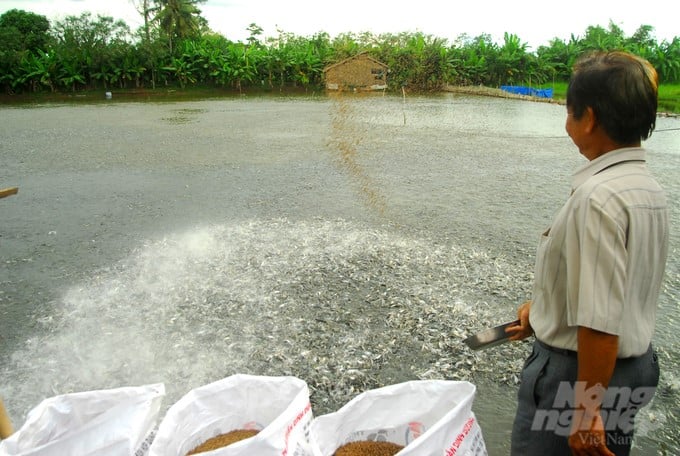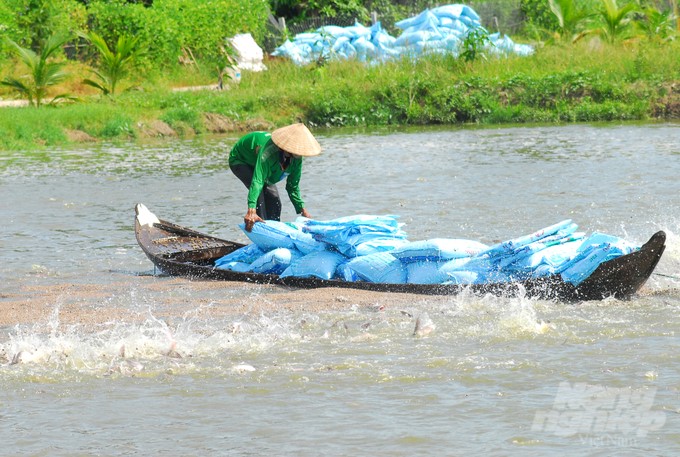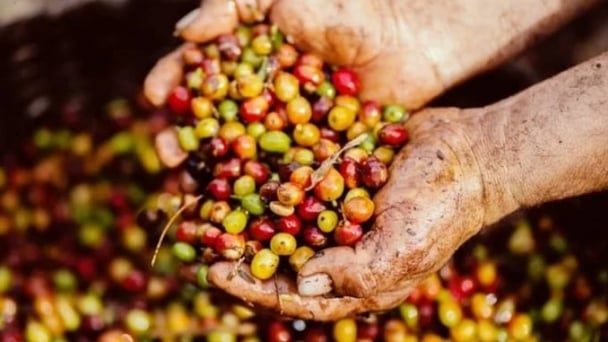June 18, 2025 | 12:22 GMT +7
June 18, 2025 | 12:22 GMT +7
Hotline: 0913.378.918
June 18, 2025 | 12:22 GMT +7
Hotline: 0913.378.918

An Giang is the “birthplace” of baby pangasius production and commercial pangasius farming professions. Photo: Le Hoang Vu.
The Mekong Delta has Tien and Hau rivers with a length of about 220 km/river and suitable hydrological conditions, which is favorable for the development of aquaculture activities on riverside ponds and dunes.
An Giang is the “birthplace” of baby pangasius production and commercial pangasius farming professions in the Mekong Delta. In addition, this province also has many aquaculture activities with different forms and diverse farming objects such as snakehead fish, tilapia, chitala chitala, swamp eel, and giant freshwater prawns.
In recent years, the loss rate of aquaculture has been increasingly high, even over 50% of the loss in some fish and shrimp ponds, greatly affecting farmers’ economic efficiency. So, the An Giang agriculture sector has deployed drastically and synchronously many solutions to limit this damage.
Ms. Vo Thi Thanh Van, Deputy Director of the An Giang Department of Agriculture and Rural Development, said: "Over the past time, the province’s agriculture sector has actively coordinated with departments, branches, and localities in the area to develop high-tech agricultural production and achieved many outstanding results."
Of which, aquaculture such as pangasius, seed production, eel, all-male giant freshwater prawn, giant barb, etc., in the direction of high-tech applications all increase in yield, output, and profit by 20 - 50%, depending on the farming model.
The An Giang agriculture sector has replicated many aquaculture models and recommended people increase the use of microbial products and limit the use of antibiotics in livestock. The actions aim to both ensure product quality and protect the environment, thereby contributing to the socio-economic growth of localities in the province.
Initial results are assessed as having positive and effective changes. Specifically, production methods have gradually changed, such as reducing the use of antibiotics in aquaculture, increasing the use of microorganisms, applying new science and technology, and focusing on organizing production associated with consumption linkages. Products improved in quality and competitiveness in the market, and production thinking gradually changed.
According to Ms. Van, currently, most people in the area have implemented high-tech aquaculture, helping to reduce risks and increase income. Thanks to this model, it is also more favorable for output products compared to traditional farming methods.
Effective farming models with technologically advanced applications and good farming practices according to quality standards are increasingly expanding. Up until now, An Giang’s area of pangasius farming according to export standards such as ASC, BAP, etc. has reached over 500 ha, with a harvest output of approximately 270,000 tons/year.

The An Giang Department of Agriculture and Rural Development directs the An Giang Sub-Department of Fisheries to periodically monitor the shoal of pangasius broodstock in terms of aquatic veterinary medicine at the farms. Photo: Le Hoang Vu.
In order to maintain a large output of pangasius for the needs of export and domestic consumption, An Giang's agriculture sector plans to develop in a sustainable way and strengthen aquatic veterinary medicine with recommendations for farming households, cooperatives, and businesses to have effective disease-prevention measures for pangasius.
In order to keep the pangasius shoal healthy and develop well to meet the needs of export at the end of this year, the An Giang Department of Agriculture and Rural Development directs the An Giang Sub-Department of Fisheries to periodically monitor the shoal of pangasius broodstock in terms of aquatic veterinary medicine at the Tan Chau town, Phu Tan, Chau Thanh, and Chau Phu districts, Chau Doc city, etc. At the same time, inspect and maintain the conditions for commercial pangasius production and pangasius breeding in the whole province.
Besides, strengthen the inspection and maintenance of conditions for food and environmental treatment product production. Carry out several rounds of monitoring the water environment of the key pangasius farming area at 7 monitoring points in Chau Thanh, Cho Moi, Phu Tan, An Phu, and Chau Phu districts. Currently, An Giang is receiving the high-quality reserve pangasius broodstock shoal. The additional objective is to gradually replace the existing broodstock shoal with the pangasius shoal, which has improved genetically in growth rate, fillet, and disease resistance.
According to Mr. Tran Anh Dung, Director of the An Giang Sub-Department of Fisheries, since 2017, the province's baby pangasius production facilities have received 12,320 good-quality reserve and spawning broodstock from the Research Institute for Aquaculture No.2 (RIA 2) to supplement and replace the facility’s pangasius broodstock shoal, thereby contributing to improving the quality of baby pangasius produced and supplied for the province’s 3-level pangasius linkage chains.
Regarding the implementation of 3-level pangasius seed production linkage activities in An Giang province, Mr. Tran Anh Dung said that so far, An Giang has deployed and formed three linkage chains on 3-level pangasius seed production, with components including RIA 2 (level 1), the Fisheries Breeding Center, and satellite establishments producing baby pangasius (level 2) and pangasius breeding branches (level 3). Annually, the 3-level linkage chains produce and supply about 8–10 billion baby pangasius and about 800-1,000 million pangasius fingerlings/year.
At level 1, as of now, RIA 2 has provided over 12,000 reserve and spawning pangasius broodstock for the province’s level 2 establishments, thereby contributing to improving the quality of baby pangasius produced and supplied in the linkage chain.
Level 2 includes An Giang Fisheries Breeding Center and four baby pangasius production facilities associated with the center and businesses with a total of 26,300 broodstock and the capacity to supply 10 billion fry/year.
Level 3 includes three fingerling production branches, namely AFA, Chau Phu, and Phu Thuan, with a total of 54 members concentrated in localities such as Thoai Son, Chau Thanh, Chau Phu, and Long Xuyen City. The total breeding area is 251 ha, and seed production capacity is 800 - 900 million heads/year.
Regarding the progress of deploying concentrated pangasius breeding areas, the province has called on four businesses investing in high-tech concentrated breeding areas to participate in the 3-level pangasius project, such as Viet Uc JSC (104 ha), Nam Viet One Member LLC (600 ha, with 150 ha of breeding in Chau Phu district), Vinh Hoan JSC (48.3 ha), and Loc Kim Chi Development LLC (350 ha). Thereby, they will contribute to improving the quality of pangasius seed in An Giang province in the coming time.
Translated by Huyen Vu Thu
![Turning wind and rain into action: [8] Real-time salinity detection and early warning technology](https://t.ex-cdn.com/nongnghiepmoitruong.vn/608w/files/news/2025/06/17/z6704423696987_15fd32ffc26d590d204d520c9dac6786-nongnghiep-151127.jpg)
(VAN) Thanks to the integration of modern hydrological-hydraulic models, remote sensing technologies, and artificial intelligence, the accuracy of hydrological forecasting has significantly improved.
![Turning wind and rain into action: [7] Early disaster warnings help marine farmers minimize losses](https://t.ex-cdn.com/nongnghiepmoitruong.vn/608w/files/news/2025/06/17/z6704423696987_15fd32ffc26d590d204d520c9dac6786-nongnghiep-142942.jpg)
(VAN) In recent years, thanks to early disaster warnings and forecasting, marine farmers in Khanh Hoa province have been able to reduce risks and losses, thereby improving production efficiency.
![Turning wind and rain into action: [6] ‘Four on-the-spot’ disaster management software](https://t.ex-cdn.com/nongnghiepmoitruong.vn/608w/files/news/2025/06/17/e5a48259d6a262fc3bb3-nongnghiep-183800.jpg)
(VAN) By simply activating the scenario on the disaster management software, the relevant authorities immediately know how many households need to be evacuated, where to evacuate them to, and by what means of transportation…
![Turning wind and rain into action: [5] Hue applies modern technology in disaster forecasting](https://t.ex-cdn.com/nongnghiepmoitruong.vn/608w/files/news/2025/06/17/z6704423696987_15fd32ffc26d590d204d520c9dac6786-nongnghiep-093938.jpg)
(VAN) In Hue city, modern technology has recently been applied in meteorological and hydrological forecasting and warning, helping to reduce the damage caused by natural disasters.

(VAN) A cutting-edge farming technique being implemented on an experimental ranch in Arizona's Sonoran Desert has already saved a billion gallons of water over five years, according to Civil Eats.

(VAN) Poultry and pig production and the environment can be boosted through enhanced water technology, according to new research.

(VAN) Coffee prices on June 16, 2025 are unchanged. In Vietnam, local trading prices are holding steady, ranging around VND 112,000 – VND 112,500/kg.